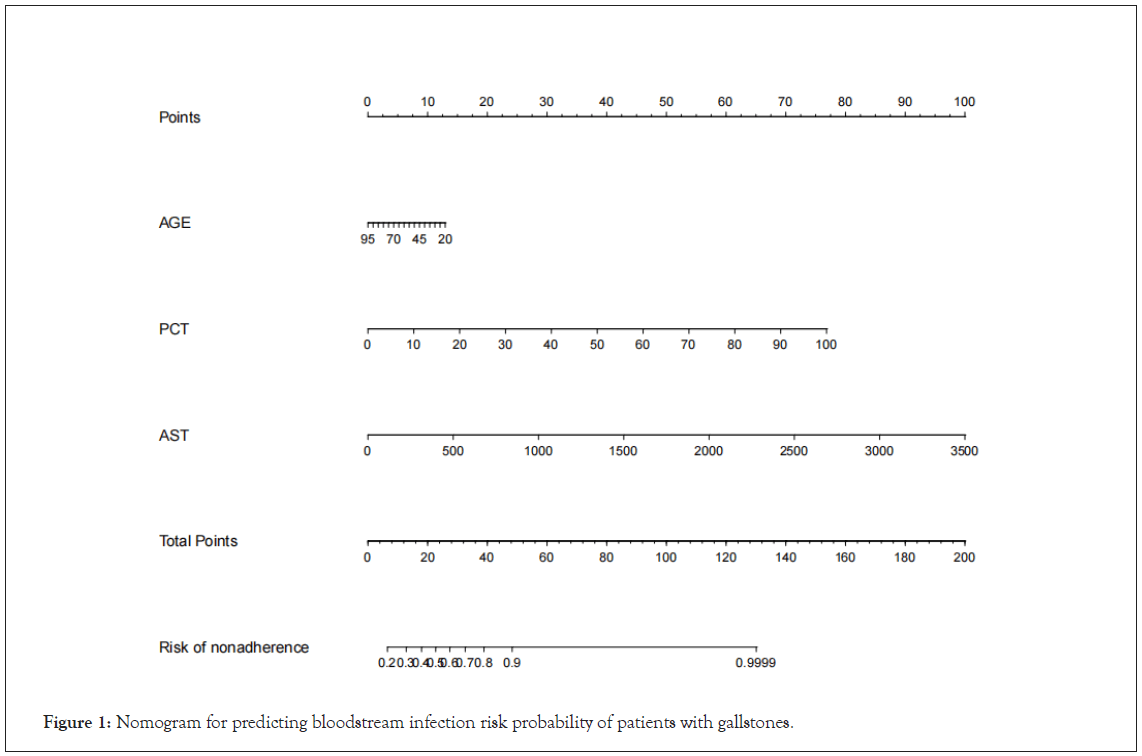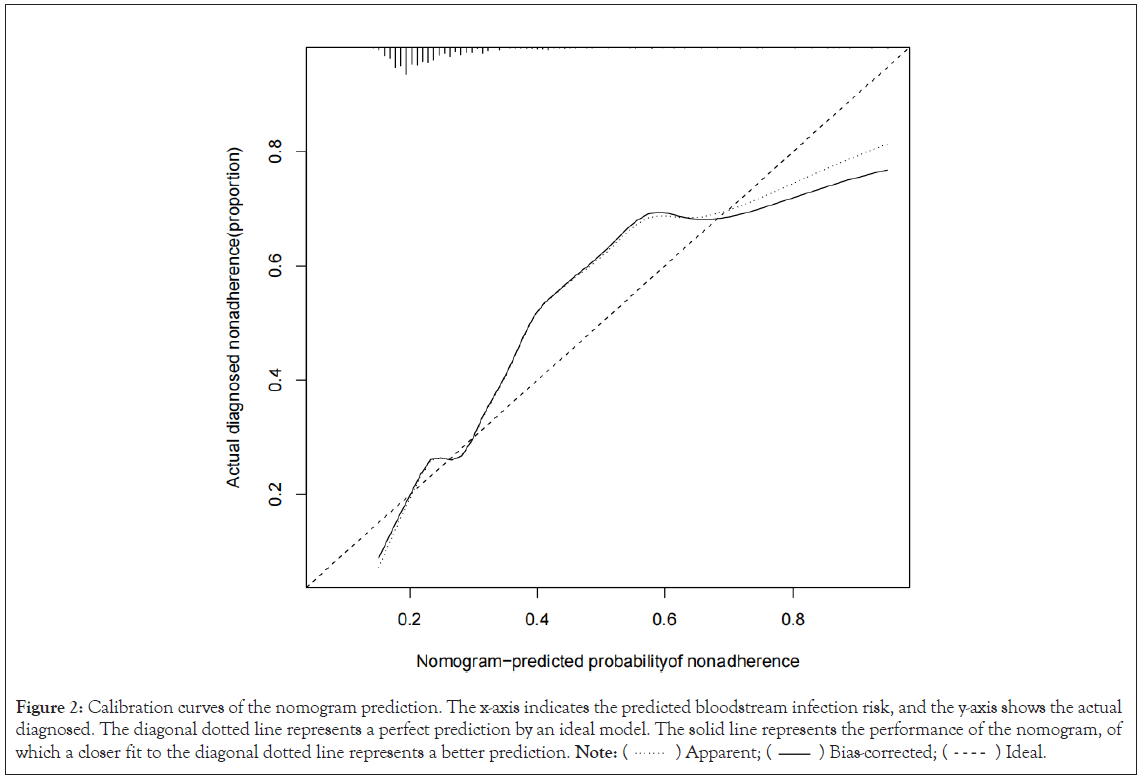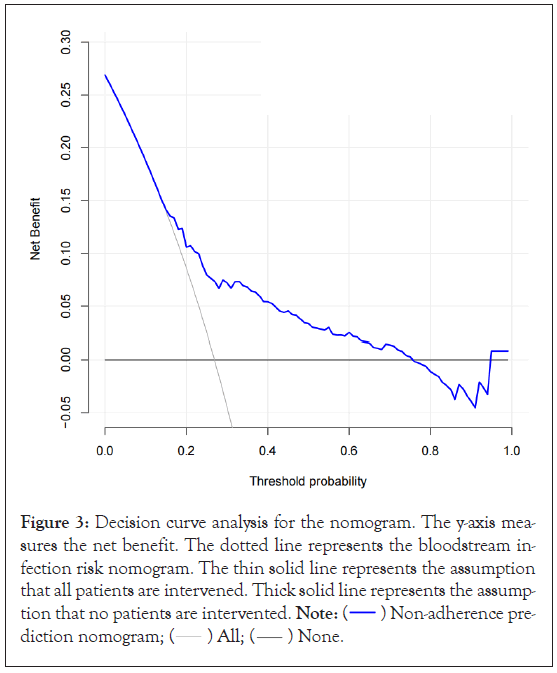
Journal of Clinical Trials
Open Access
ISSN: 2167-0870

ISSN: 2167-0870
Research Article - (2024)Volume 14, Issue 2
Objective: The objective of this study was to create and authenticate a user-friendly nomogram for assessing the risk of Bloodstream Infections (BSI) in patients with gallstones.
Materials and methods: Data on 261 patients without BSI and 96 patients with BSI who had gallstones were gathered between January 2019 and April 2023. The ten variables—age, sex, White Blood Cell (WBC), Neutrophil (NE%), calcitonin (PCT), γ-Glutamyltransferase (GGT), Total Bilirubin (TBIL), Direct Bilirubin (DBIL), Alkaline Phosphatase (ALP), and glutamic oxaloacetic transaminase (AST)—were first screened using the single-factor regression analysis. Multiple regression analyses were used to optimize the risk model's predictive features. The prediction model's discrimination, calibration, and clinical application performance were evaluated using the consistency index (c-index), calibration curve, and Clinical Decision Curve (DCA).
Results: Nine variables show no multicollinearity, with the exception of gender, according to collinearity analysis. Multiple logistic regression analysis was included to select age, PCT, and AST predictors. Among them, age [OR=0.562 (0.366–0.939), P=0.028] is a protective factor for gallstone patients with blood flow infection (P<0.05), whereas PCT [OR=2.115 (1.244–3.597), P=0.006], and AST [OR=3.469 (1.942–6.198), P=0.000] are risk factors for concurrent BSI in gallstone patients with gallstones (P<0.05). On the basis of the anticipated variables, a prediction model was created. With a bootstrap validation of 0.7 and a C-index of 0.71, the prediction model's validation shows sufficient discrimination. The calibration curve showed how well the model can be corrected and how accurate its predictions are. The DCA results demonstrated that the predictive model was clinically effective when the threshold probability was between 17%–77%, as the net return was more significant than the two extreme models.
Conclusion: As an additional technique for predicting individuals with gallstones complicated by blood flow infection, the nomogram has some predictive power.
Nomogram; Prediction; Bloodstream infection; Gallstone patient
Cholelithiasis is a common disease of the dehydrating system in which gallstones form in the bile capsule or bile duct [1,2]. Based on the location of gallstones, they can be divided into gallbladder calculus, bile duct calculus, and a combination of gallbladder and bile duct calculus [3]. With a 20% frequency, gallstones are among the most frequent causes of admission to surgical wards. The gallbladder is where gallstones usually originate, however they can also occur throughout the biliary tract. The majority of gallstones are made of dietary cholesterol. Risk factors for gallstones and gallstone-related disease are female gender, obesity, and rapid weight loss [4]. Acute calculous cholecystitis is the most common complication of gallstones, accounting for one-third of all emergency surgical admissions for calculi [5]. Cholecystitis is brought on by the pathogenic bacteria infecting the gallbladder, which then swiftly enters the bloodstream and causes infection.
Bloodstream Infection (BSI) is a significant global public health burden. Diagnosing BSI is one of the most critical functions of clinical microbiology [6]. Delayed effective therapy is associated with worse outcomes, and fast and accurate diagnosis of the causative microorganism enhances the care of BSI patients [7-11]. The typical pathogenic bacterial culture was 2–4 days for a positive BSI, which is too slow to affect acute patient management [12]. Therefore, it's critical to develop techniques or instruments that can accurately forecast the illness.
Recently, the nomogram has been extensively used as a predictive method in clinical disease. Jinjin Wang ect. founded microbiology and prognostic prediction model of bloodstream infection in patients with hematological malignancies [13]. Sun et al. constructed predictive models for sepsis in children with Staphylococcus aureus bloodstream infections: a retrospective cohort study [14]. Mei et al. established a nomogram to predict hyperkalemia in patients with hemodialysis [15]. Wang et al. built nomogram on account of Lasso-Cox regression for predicting recurrence in patients with early-stage hepatocellular carcinoma [16]. Tong C set up a novel nomogram for predicting the decision to delayed extubation after thoracoscopic lung cancer surgery [17]. Further, no effective and well-performing model was established for predicting bloodstream infection in gallstone patients.
In this work, we use multivariate logistic regression to create a risk assessment model based on a set of standard laboratory blood markers. Additionally, through internal validation, we increased accuracy and enhanced the evaluative performance. Ultimately, the model's primary advantage was its ability to produce data supporting the management and prevention of BSIs in gallstone patients.
Patients
The provincial hospital in Fujian provided consent for the research. From January 2019 to April 2023, patients from the provincial hospital in Fujian, China, were gathered. Patients who had been diagnosed with gallstones were included in the study. Written informed consent was acquired by each participating patient.
To screen patients, we used the inclusion criteria listed below: (1) Gallstone diagnosis for the patient; (2) Positive blood culture; and (3) Comprehensive clinical information. The following were the exclusion criteria: Four patients have been identified: (1) non-gallstone patient; (2) HIV patient; (3) patient with malignant tumors; and (4) lacking clinical data.
Data management and statistical analysis
The details were as follows: ID number, clinical diagnosis, gender, age, white blood cell count, neutrophil count, Procalcitonin (PCT), Gamma-Glutamyltransferase (GGT), Total Bilirubin (TBIL), Direct Bilirubin (DBIL), Alkaline Phosphatase (ALP), Aspartate Aminotransferase (AST). R software (version 4.1.2) and SPSS 2.0.0 were used for statistical analyses. The mean ± standard deviation or median (interquartile range) values described continuous variables, however, categorical variables were presented as percentages. We conducted a logistic regression analysis to identify independent variables; nevertheless, Variance Inflation Factor (VIF) and tolerance (Rol) were used to diagnose multicollinearity among independent variables. We then selected related variables using multivariate logistic regression analysis on the independent variables to calculate estimated Odds Ratios (ORs) and 95% Confidence Intervals (CIs). We subsequently used the selected features to establish a nomogram. Harrell's C-index was applied to evaluate the discrimination of the nomogram. The nomogram was subjected to bootstrapping validation (1,000 bootstrap resamples) to calculate a relatively corrected C-index. The calibration curve was measured to quantify the nomogram's calibration performance. Decision curve analysis was conducted to determine the clinical usefulness of the nomogram.
Patients' characteristics
After applying the inclusion and exclusion criteria to analyze data, 357 gallstone patients were included in this study (Supplementary Table 1). The characteristics of 96 BSI and 261 non-BIS patients are listed in Supplementary Table 1. Among them, age (P=0.030), WBC (P=0.006), NUE (P=0.088), PCT (P=0.001), GGT ((P=0.032), TBIL (P=0.000), DBIL (P=0.001), ALP (P=0.011) and AST (P=0.000) have significant differences between the BSI and non-BSI groups (P<0.1). Collinearity diagnosis was conducted on the statistically significant features. The TOL of all variables is greater than 0.1, and the VIF is less than 10, which does not have collinearity (Supplementary Table 2).
Multivariate logistic regression variable screening results and nomogram development
The risk factors associated with bloodstream infection and gallstone patients after multivariate logistic regression are listed in Supplementary Table 3. There into, PCT [OR=2.115 (1.244–3.597), P=0.006] and AST [OR=3.469 (1.942–6.198), P=0.000] were risk factors for gallstones complicated with bloodstream infection, however, age [OR=0.562 (0.366–0.939), P=0.028] was a protective factor for gallstones combined with bloodstream infection. The nomogram shown in Figure 1, predicted bloodstream infection risk probability of patients with gallstones was constructed based on this model. While using it, a vertical line was drawn from each variable upward to the points, and then the corresponding points were recorded (i.e., “PCT=10”=16 points). The point of each variable was then summed up to obtain a total score corresponding to a predicted probability of bloodstream infection at the bottom of the nomogram.

Figure 1: Nomogram for predicting bloodstream infection risk probability of patients with gallstones.
Performance of the risk nomogram in the cohort
Figure 2, demonstrates that the calibration curve of the nomogram used to predict the risk of bloodstream infection in patients with gallstones showed good agreement in this cohort. The C-index for the prediction nomogram was 0.710 (95% CI: 0.650–0.770) for the cohort and was confirmed to be 0.700 through bootstrapping validation, indicating the model's decent discrimination.

Figure 2: Calibration curves of the nomogram prediction. The x-axis indicates the predicted bloodstream infection risk, and the y-axis shows the actual
diagnosed. The diagonal dotted line represents a perfect prediction by an ideal model. The solid line represents the performance of the nomogram, of
which a closer fit to the diagonal dotted line represents a better prediction. Note:  Ideal.
Ideal.
Clinical use of the nomogram
The decision curve analysis was employed to evaluate the nomogram's clinical advantages. The decision curve displayed that if the threshold probabilities of a patient and a physician are>17 and<77%, respectively, using this nomogram to predict bloodstream infection risk has better clinical effectiveness than the intervention-all-patients scheme or the intervention-none scheme (Figure 3).

Figure 3: Decision curve analysis for the nomogram. The y-axis measures the net benefit. The dotted line represents the bloodstream infection risk nomogram. The thin solid line represents the assumption
that all patients are intervened. Thick solid line represents the assumption that no patients are intervented. Note:  Non-adherence prediction nomogram;
Non-adherence prediction nomogram;  None.
None.
Figure 3, decision curve analysis for the nomogram. The y-axis measures the net benefit. The dotted line represents the bloodstream infection risk nomogram. The thin solid line represents the assumption that all patients are intervened. Thick solid line represents the assumption that no patients are intervened.
Gallstone Disease (GSD) is among the most common biliary tract diseases worldwide. Genetic and environmental factors have roles in its pathogenesis [17]. Gallstone formation is multifactorial, involving a complex interplay of sex-specific, genetic, lifestyle, and comorbidity-related factors [18]. A bloodstream infection is a pathogenic organism in the bloodstream that causes disease. It is typically defined by the growth of a pathogenic organism in culture or by the development of an atypical organism in conjunction with infection symptoms [19]. Bloodstream infections are a severe disease of nosocomial infections with a high mortality rate. In recent years, Catheter-associated Bloodstream Infections (CRBSI) have been the primary cause of bloodstream infections, and the associated complications are serious [20]. Bloodstream infection is a common complication in patients with gallstones. Gallstones are the cause of cholestasis and can easily lead to bacterial infection. Via the portal system, these bacteria rapidly induce bloodstream infections. The bacterial culture approach is quite accurate and specific. however, it is incredibly time-consuming. Therefore, it is essential to provide strategies that can effectively predict the disease to prevent its occurrence, monitor its progression, and enhance the prognosis of patients.
Nomograms relied on user-friendly digital interfaces, enhanced accuracy, and easily comprehended prognoses to improve clinical decision-making [21]. By forecasting patient outcomes and providing pertinent risk indicators and scores, they make disease monitoring easier. Individual clinical outcomes can be predicted based on a patient's individual characteristics, allowing for more individualized treatment [22]. Jian et al. reported a nomogram model for predicting the prognosis of obstructive colorectal cancer [23]. They also established a nomogram to assist healthcare professionals in assessing the risk of bullying victimization among adolescents, identifying high-risk groups, and implementing more effective preventive measures [24]. Yinlong et al. found that nomograms can predict in-hospital mortality in ICU patients with sepsis and lung infection [25]. Xiaoyu et al. built a nomogram for clinical estimation of acute biliary pancreatitis risk among patients with symptomatic gallstones [26]. Furthermore, this nomogram was not previously applied to gallstones or bloodstream infections until this study.
In this study, 357 patients with gallstones were included. Three optimal predictors were selected by multivariate logistic regression: age, PCT, and AST, and then a nomogram model was established. Relevant studies have reported that liver dysfunction is an early sign of BSI [27]. WBC count, NE%, PCT, γ-GGT, TBIL, DBIL, ALP, and AST [28-32], are associated with liver dysfunction. The prediction model was consistent with the actual diagnosis and had good accuracy. The decision analysis curve demonstrated that when the threshold probability is 17%-77%, the nomogram is more clinically effective, which can serve as a theoretical reference for the individualized clinical prevention of gallstones complicated with bloodstream infection.
In the process of a bloodstream infection, pathogenic bacteria in the blood cause increased WBC and NE. PCT is elevated in patients with bloodstream infections due to the stimulation of various organs by inflammatory factors. A large amount of procalcitonin will be produced into the blood, significantly increasing serum procalcitonin level. This study revealed that PCT [OR=2.115 (1.244–3.597), P=0.006] and AST [OR=3.469 (1.942–6.198), P=0.000] were risk factors for gallstones complicated by bloodstream infection. Similar to previous research, a predictive biomarker indicating the risk of bacterial infections could guide clinical assessment and assist in the decision-making process for the judicious use of antimicrobials. In this regard, the use of a host-response marker, Procalcitonin (PCT), has received ample scientific attention recently as an adjunct to clinical judgment [33]. Nevertheless, age [OR=0.562 (0.366–0.939), P=0.028] was a protective factor for gallstones complicated with bloodstream infection. There has been reported that the rate of bloodstream infection increases with age [34]. This difference may be related to the selected demographics. There are numerous risk factors for bloodstream infection, and a single risk factor cannot be used to determine whether gallstones are complicated by bloodstream infection, only by relying on a single risk factor. In this study, a nomogram prediction model was constructed using the optimized features, and the prediction efficiency was assessed. The nomogram model can recognize individualized prediction of clinical disease risk and has been extensively used in research [35,36]. The clinician can predict the incidence of gallstones complicated with bloodstream infection by adding the scores corresponding to each independent risk factor on the nomogram and the predicted values through the total score.
This study developed and validated a user-friendly nomogram to predict the risk of Bloodstream Infections (BSI) in patients with gallstones. The nomogram incorporates three factors: age, Procalcitonin (PCT), and Aspartate Aminotransferase (AST) levels. The model demonstrated good discrimination and calibration, suggesting its potential for clinical application.
However, limitations exist, including a small sample size, single- center design, and lack of external validation. Future studies should address these limitations and incorporate additional factors to improve the model's accuracy and generalizability.
Overall, this nomogram offers a promising tool for clinicians to aid in the individualized assessment and management of BSI risk in patients with gallstones.
This study was supported by Startup Fund for scientific research, Fujian Medical University (2022QH1307) and scientific research, Fujian Medical University (2019QH1166).
The authors have no relevant financial or non-financial interests to disclose.
All authors contributed to the study conception and design. Material preparation, data collection and analysis, and first draft of the manuscript were performed by Xiuqing Shen, Changsheng Wu, Pengju Cao, Shaoting Chen and Falin Chen. Rongxin Zhong and Sijie Wang commented on previous versions of the manuscript, checked data and revised the manuscript pictures and supervision. All authors read and approved the final manuscript.
[Crossref] [Google Scholar] [PubMed]
[Crossref] [Google Scholar] [PubMed]
[Crossref] [Google Scholar] [PubMed]
[Crossref] [Google Scholar] [PubMed]
[Crossref] [Google Scholar] [PubMed]
[Crossref] [Google Scholar] [PubMed]
[Crossref] [Google Scholar] [PubMed]
[Crossref] [Google Scholar] [PubMed]
[Crossref] [Google Scholar] [PubMed]
[Crossref] [Google Scholar] [PubMed]
[Crossref] [Google Scholar] [PubMed]
[Crossref] [Google Scholar] [PubMed]
[Crossref] [Google Scholar] [PubMed]
[Crossref] [Google Scholar] [PubMed]
[Crossref] [Google Scholar] [PubMed]
[Crossref] [Google Scholar] [PubMed]
[Crossref] [Google Scholar] [PubMed]
[Crossref] [Google Scholar] [PubMed]
[Crossref] [Google Scholar] [PubMed]
[Crossref] [Google Scholar] [PubMed]
[Crossref] [Google Scholar] [PubMed]
[Crossref] [Google Scholar] [PubMed]
[Crossref] [Google Scholar] [PubMed]
[Crossref] [Google Scholar] [PubMed]
[Crossref] [Google Scholar] [PubMed]
[Crossref] [Google Scholar] [PubMed]
[Crossref] [Google Scholar] [PubMed]
[Crossref] [Google Scholar] [PubMed]
[Crossref] [Google Scholar] [PubMed]
[Crossref] [Google Scholar] [PubMed]
[Crossref] [Google Scholar] [PubMed]
[Crossref] [Google Scholar] [PubMed]
[Google Scholar] [PubMed]
[Crossref] [Google Scholar] [PubMed]
[Google Scholar] [PubMed]
[Crossref] [Google Scholar] [PubMed]
Citation: Shen X, Wu C, Zhong R, Chen F, Wang S, Cao P (2024) Development and Assessment of an Efficient Predictive Nomogram for Bloodstream Infection in Gallstone Patients. J Clin Trials. 14:552.
Received: 01-Jan-2024, Manuscript No. JCTR-23-28902; Editor assigned: 03-Jan-2024, Pre QC No. JCTR-23-28902(PQ); Reviewed: 17-Jan-2024, QC No. JCTR-23-28902; Revised: 24-Jan-2024, Manuscript No. JCTR-23-28902(R); Published: 31-Jan-2024 , DOI: 10.35248/2167-0870.24.14.552
Copyright: © 2024 Shen X, et al. This is an open-access article distributed under the terms of the Creative Commons Attribution License, which permits unrestricted use, distribution, and reproduction in any medium, provided the original author and source are credited.